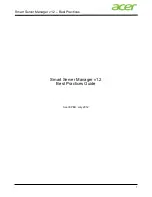
To define which characters to display, from the main menu click
Window
→
Preferences
, expand
SlickEdit
and click
General
in the tree, then double-click the
General
setting and select the
Special
Characters
tab. See
Defining Special Characters
below.
Note
Viewing special characters is only available for ASCII files.
Special Character Toggles
The following toggles are available on the view menu:
• Hex Toggle
• Line Hex Toggle
• Special Characters Toggle
• New Line Characters Toggle
• Tab Characters Toggle
• Space Characters Toggle
• Line Numbers Toggle
Defining Special Characters
To define what characters to display when viewing special characters, from the main menu, click
Window
→
Preferences
, expand
SlickEdit
and click
General
in the tree, then double-click the
General
setting
and select the
Special Characters Tab
. Enter the character codes that you wish to use.
To view the differences between a DOS format text file and another format when
View
→
New Line
Chars
is active, choose something other than a space for the
End-Of-Line (2)
character. Under Win-
dows, the recommended choices are
13
for
End-Of-Line (1)
and
10
for
End-Of-Line (2)
.
To change the colors and styles of special characters, from the main menu click
Window
→
Preferences
, expand
SlickEdit
and click
General
in the tree, then double-click the
Color
setting. Select
Special Characters
from the screen element drop-down list. For more information on color settings, see
Setting Fonts and Colors
.
Selective Display
Selective Display (also known as
code folding
) is a convenient way to display or hide regions of your
code, so that you can view and manage only those regions that are relevant to your current editing ses-
sion.
Use the Selective Display dialog to activate this feature and to specify the type of regions to display or
Selective Display
224
Summary of Contents for Corev3.3 for Eclipse
Page 1: ...Think Slick Corev3 3 for Eclipse...
Page 2: ......
Page 3: ...SlickEdit Core v3 3 for Eclipse...
Page 5: ......
Page 6: ......
Page 14: ...xii...
Page 20: ...xviii...
Page 22: ...xx...
Page 23: ...Chapter 1 Introduction 1...
Page 41: ...Chapter 3 User Interface 19...
Page 61: ...Chapter 4 User Preferences 39...
Page 80: ...BODY BODY HTML HTMLEOF Restoring Settings on Startup 58...
Page 82: ...60...
Page 83: ...Chapter 5 Context Tagging 61...
Page 97: ...Chapter 6 Editing Features 75...
Page 124: ...Code Templates 102...
Page 238: ...Figure 6 49 Test Parsing Configuration Example 1 C Refactoring 216...
Page 241: ...Figure 6 51 Test Parsing Configuration Example 3 Reviewing Refactoring Changes 219...
Page 250: ...228...
Page 251: ...Chapter 7 Language Specific Editing 229...
Page 328: ...306...
Page 329: ...Chapter 8 Tools and Utilities 307...
Page 350: ...328...
Page 351: ...Chapter 9 Macros and Macro Programming 329...
Page 360: ...338...
Page 361: ...Chapter 10 SlickEdit Core Dialogs 339...
Page 375: ...Find and Replace View 353...
Page 491: ...Chapter 11 Appendix 469...
Page 567: ......
Page 568: ......
















































